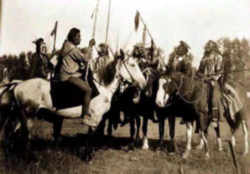


North Carolina Symbols
North Carolina Early History
First Early Inhabitants of North Carolina

Early history examines the archaeological record that tells the story of the first inhabitants of North Carolina. Learn about the prehistory and culture of the first early inhabitants, and what lessons it might teach us about the early history of North Carolina.
North Carolina First Early Inhabitants Timeline
- 620Mil BC - In 1975 animal fossils of about this time were discovered in North Carolina.
- Ancient times - The Eastern half of the state was underwater, and giant megalodon sharks roamed the waters. On land, there were wooly mammoths and mastodons. Archaeologists believe the first Native Americans crossed into the New World from Siberia some 12,000 to 10,000 years ago.
- Prior to 1500 - Approximately 30 Native American tribes are scattered across North Carolina. Chief among these are the Cherokee, the Catawba, the Tuscarora, and the Croatans. Native Americans build the Town Creek Indian Mound.
- 1000 AD - Woodland Period - homes were established along rivers and trade exchange systems and burial systems were established
- 1688 1763 - The French and Indian Wars between France and Great Britain for lands in North America consisting of King William's War (1688-1699), Queen Anne's War (1702-1713), King George's War (1744 - 1748) and the French and Indian War aka the Seven Years War (1754-1763)
- 1702 - 1713 - Queen Anne's War (part of the French and Indian Wars) between the French and Spanish colonies allied with the Wabanaki Confederacy, Mohawk, Choctaw, Timucua, Apalachee and Natchez tribes against the British colonies allied with the Muscogee (Creek), Chickasaw and Yamasee tribes.
- 1711 - 1713 - Tuscarora War, North Carolina between the British, Dutch and German settlers against the Tuscarora led by King Hancock.
- 1715 - The Yamasee War - An Indian confederation led by the Yamasee came close to exterminating the white settlements in their area
- 1754; - 1763 - The French Indian War is won by Great Britain against the French so ending the series of conflicts known as the French and Indian Wars
- 1758 - The Anglo-Cherokee War (1758–1761) - The Cherokee uprising in present-day Tennessee, Virginia and the Carolinas
Early History of Native Americans in North Carolina
The Indigenous People of North Carolina
The names of the North Carolina tribes included the Algonquian, Bear River Indians, Cape Fear Indians, Catawba, Cheraw, Cherokee, Chowanoc, Machapunga, Moratok, Natchez, Occaneechi, Saponi, Shakori, Tuscarora and Waccamaw tribes.
At the time of the first European contact, North Carolina was inhabited by a number of native tribes sharing some cultural traits, but also distinguished by regional and linguistic variations. Three major language families were represented in North Carolina: Iroquoian, Siouan, and Algonquian based upon their native languages: Iroquois (including the Cherokee, Tuscarora, Meherrin, Coree, and Neuse River tribes), Algonquin (including the Bear River, Chowan, Hatteras, Nachapunga, Moratok, Pamlico, Secotan, and Weapomeoc tribes), and Siouan (including the Cape Fear, Catawba, Cheraw, Eno, Keyauwee, Occaneechi, Saponi, Shakori, Sissipahaw, Sugaree, Tutelo, Waccamaw, Wateree, Waxhaw, and Woccon tribes). The Iroquois tribes inhabited the mountains in the western portion of the state. The Siouan tribes lived in the central piedmont area, and the Algonquin tribes lived in the southern tidewater area.
Experts believe approximately 7,000 coastal Algonquin people lived in the area prior to contact with Europeans in the 16th century. Many of these
had migrated from the north. There were probably around 6,000 people from Siouan tribes, although we know very little about these groups prior to the
settlement of Europeans. They seem to have been a loosely connected alliance of tribes who eventually joined with the Catawba tribe. The largest of
the three groups of natives was the Cherokee, a part of the Iroquois tribes, who had probably migrated southward into the Appalachian Mountains prior
to the time of Columbus' exploration of the New World.





